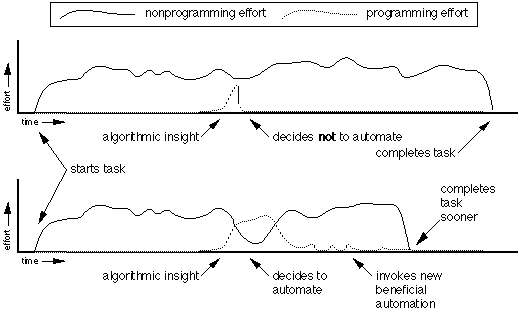
Just-in-time programming is the implementing of algorithms during task-time, the time when the user is actually trying to accomplish the task. It can be characterized by a situation with the following components:
In short, the goal of just-in-time programming is to allow users to profit from their task-time algorithmic insights by programming. Instead of automating with software that was carefully designed and implemented much earlier, the user recognizes an algorithm and then creates the software to take advantage of it just before it is needed, hence implementing it just in time.
It is worth emphasizing that the user's task could be from any domain (e.g. graphic drawing, scientific visualization, word processing, etc.) and that the algorithm originates with the user. Obviously, a user with more programming experience will be able to envision a more complex algorithm than a novice user. How the user comes up with the algorithm is not a concern. Also, no particular approach to solving the problem appears in the problem statement. Any programming system could conceivably be used for just-in-time programming, including C, PASCAL, keyboard macros, scripting languages, or PBD. PBD will probably be an important part of the more successful just-in-time programming systems, but the problem statement leaves open the possibility for other solutions.
Just-in-time programming research shares many of the motivations of other PBD research. Chief among these is that users often do repetitive or algorithmic subtasks that the computer could be doing. We call these subtasks potential computer subtasks and call these situations opportunities for new beneficial automation. Because automating can increase productivity and user satisfaction and at the same time reduce errors, one would expect the user to delegate potential computer subtasks to the computer. That users often do not take advantage of these opportunities motivates researching ways to improve the computer. Just-in-time programming research and PBD research assert that easier-to-use programming tools will allow users to take better advantage of opportunities for new beneficial automation.
Just-in-time programming research, however, is focused on making programming easier for a specific cross section of situations. These situations are primarily defined by the user programming during task-time. In other words, the user attempts to write a program for a task that is already in progress. Figure 1 summarizes the relationship between task progress and the user's expenditure of effort. The expenditure of effort for just-in-time programming is shown separately from the other task related effort. The difficulty of just-in-time programming results from the spreading of the user's mental resources between two activities [Cypher 86]. Another difficulty is that the time spent programming contributes directly to total time between the start and completion of the task.


back to ...  Table of Contents
Table of Contents  Watch What I Do
Watch What I Do